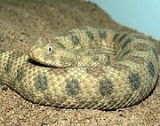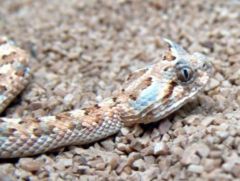
Bitis caudalis
Encyclopedia
- Common names: horned adder, horned puff adder, horned viper.
Bitis caudalis is a venomous
Venomous snake
"Poisonous snake" redirects here. For true poisonous snakes, see Rhabdophis.Venomous snakes are snakes which have venom glands and specialized teeth for the injection of venom...
viper
Viperinae
The Viperinae, or viperines, are a subfamily of venomous vipers found in Europe, Asia and Africa. They are distinguished by their lack of the heat-sensing pit organs that characterize their sister group, the Crotalinae. Currently, 12 genera and 66 species are recognized...
species
Species
In biology, a species is one of the basic units of biological classification and a taxonomic rank. A species is often defined as a group of organisms capable of interbreeding and producing fertile offspring. While in many cases this definition is adequate, more precise or differing measures are...
found in the arid region of south-west Africa
Africa
Africa is the world's second largest and second most populous continent, after Asia. At about 30.2 million km² including adjacent islands, it covers 6% of the Earth's total surface area and 20.4% of the total land area...
. Easily distinguished by the presence of a single, large horn-like scale over each eye. No subspecies are currently recognized.
Description

Botswana
Botswana, officially the Republic of Botswana , is a landlocked country located in Southern Africa. The citizens are referred to as "Batswana" . Formerly the British protectorate of Bechuanaland, Botswana adopted its new name after becoming independent within the Commonwealth on 30 September 1966...
measuring 51.5 cm.
Geographic range
The arid region of south-west Africa: south-west AngolaAngola
Angola, officially the Republic of Angola , is a country in south-central Africa bordered by Namibia on the south, the Democratic Republic of the Congo on the north, and Zambia on the east; its west coast is on the Atlantic Ocean with Luanda as its capital city...
, Namibia
Namibia
Namibia, officially the Republic of Namibia , is a country in southern Africa whose western border is the Atlantic Ocean. It shares land borders with Angola and Zambia to the north, Botswana to the east and South Africa to the south and east. It gained independence from South Africa on 21 March...
, across the Kalahari Desert
Kalahari Desert
The Kalahari Desert is a large semi-arid sandy savannah in Southern Africa extending , covering much of Botswana and parts of Namibia and South Africa, as semi-desert, with huge tracts of excellent grazing after good rains. The Kalahari supports more animals and plants than a true desert...
of southern Botswana
Botswana
Botswana, officially the Republic of Botswana , is a landlocked country located in Southern Africa. The citizens are referred to as "Batswana" . Formerly the British protectorate of Bechuanaland, Botswana adopted its new name after becoming independent within the Commonwealth on 30 September 1966...
, into northern Transvaal
Transvaal Province
Transvaal Province was a province of the Union of South Africa from 1910 to 1961, and of its successor, the Republic of South Africa, from 1961 until the end of apartheid in 1994 when a new constitution subdivided it.-History:...
and southwestern Zimbabwe
Zimbabwe
Zimbabwe is a landlocked country located in the southern part of the African continent, between the Zambezi and Limpopo rivers. It is bordered by South Africa to the south, Botswana to the southwest, Zambia and a tip of Namibia to the northwest and Mozambique to the east. Zimbabwe has three...
. In South Africa
South Africa
The Republic of South Africa is a country in southern Africa. Located at the southern tip of Africa, it is divided into nine provinces, with of coastline on the Atlantic and Indian oceans...
it is found from the northern Cape Province
Cape Province
The Province of the Cape of Good Hope was a province in the Union of South Africa and subsequently the Republic of South Africa...
south to the Great Karoo. Type locality: "... the sandy districts north of the Cape Colony..." [South Africa].
Venom
Bites are assumed to be rare and no epidemiological information is available.Little information is available regarding the toxicity and amount of venom produced. Spawls and Branch (1995) report an average yield of 85 mg of wet venom, while Christensen (1971) offers an value of 1.2 mg/kg IV
Intravenous therapy
Intravenous therapy or IV therapy is the infusion of liquid substances directly into a vein. The word intravenous simply means "within a vein". Therapies administered intravenously are often called specialty pharmaceuticals...
.
Based on this LD50 value, Spawls and Branch (1995) estimated that about 300 mg of this venom would be required to kill an adult. They regard this venom as one of the weakest of the genus although it must be mentioned that the tests are conducted solely on mice which might have a different reaction from humans to the venom. On the other hand, an older report by the U.S. Navy (1965, 1991) suggests that it is highly toxic and that a number of deaths have occurred as a result. According to Broadley and Cock (1975), envenomation symptoms in humans include swelling, severe pain, nausea, vomiting and shock. Blisters and necrotic ulcers may form around the bite site.
The National Antivenom and Vaccine Production Centre in Riyadh
Riyadh
Riyadh is the capital and largest city of Saudi Arabia. It is also the capital of Riyadh Province, and belongs to the historical regions of Najd and Al-Yamama. It is situated in the center of the Arabian Peninsula on a large plateau, and is home to 5,254,560 people, and the urban center of a...
, Saudi Arabia
Saudi Arabia
The Kingdom of Saudi Arabia , commonly known in British English as Saudi Arabia and in Arabic as as-Sa‘ūdiyyah , is the largest state in Western Asia by land area, constituting the bulk of the Arabian Peninsula, and the second-largest in the Arab World...
, produces a polyvalent antivenin that includes a paraspecific antibody that protects against bites from this species. According to the U.S. Navy (1965, 1991), polyvalent
Polyvalent
In chemistry, polyvalence or multivalence refers to species that are not restricted to a distinct number of valence bonds....
antivenins produced by SAMIR and the Pasteur Institute
Pasteur Institute
The Pasteur Institute is a French non-profit private foundation dedicated to the study of biology, micro-organisms, diseases, and vaccines. It is named after Louis Pasteur, who made some of the greatest breakthroughs in modern medicine at the time, including pasteurization and vaccines for anthrax...
are said to be effective, while Mallow et al. (2003) report that currently available antivenins are of limited effectiveness.
Viljoen et al. (1982) isolated a protein, a neurotoxic
Neurotoxin
A neurotoxin is a toxin that acts specifically on nerve cells , usually by interacting with membrane proteins such as ion channels. Some sources are more general, and define the effect of neurotoxins as occurring at nerve tissue...
phospholipase A2
Phospholipase A2
Phospholipases A2 are enzymes that release fatty acids from the second carbon group of glycerol. This particular phospholipase specifically recognizes the sn-2 acyl bond of phospholipids and catalytically hydrolyzes the bond releasing arachidonic acid and lysophospholipids...
, from the venom, which they called "caudoxin". According to Lee et al. (1983), this is a presynaptic
Chemical synapse
Chemical synapses are specialized junctions through which neurons signal to each other and to non-neuronal cells such as those in muscles or glands. Chemical synapses allow neurons to form circuits within the central nervous system. They are crucial to the biological computations that underlie...
toxin similar to bungarotoxin
Bungarotoxin
α-Bungarotoxin is one of the components of the venom of the elapid snake Taiwanese banded krait . It binds irreversibly and competitively to the acetylcholine receptor found at the neuromuscular junction, causing paralysis, respiratory failure and death in the victim...
, but with different binding sites.

